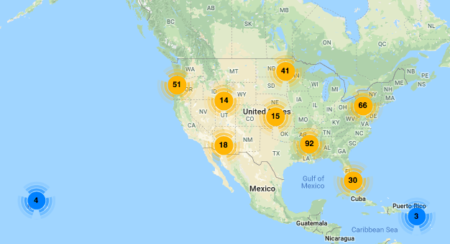- Collecting bananas in Bougainville.
- More about breeding perennial versions of staple crops.
- Surveys and statistics are not enough to better understand respective roles of women and men in food production and security.
- There are diverse farms in California too.
- GRAIN paper says farmers’ seed systems feed Africa. But surely all those community seed banks could do with support and back-up, not to mention new, additional diversity, from formal sector genebanks?
US strawberries set to invade UK
It looks like UC Davis is making a move after declaring victory in the Strawberry Wars.
The University of California has entered into a master agreement with Global Plant Genetics, Ltd., based in Norfolk, England, for the sublicensing of new strawberry varieties in selected countries within Europe, the Mediterranean and South America. The agreement governs the commercialization of new varieties from the UC Davis Public Strawberry Breeding Program located at the University of California, Davis.
I wonder how the other side is doing.
Brainfood: Conserving rice, Cypriot olives, Bambara groundnut bioactives, Chinese spuds, Ancient pastoralism, Epigenetics, Diverse rice systems, Detecting evolution, CWR & pollution, VAM, Bacterial taxonomy
- Securing Diversity for Food Security: The Case of Conservation and Use of Rice Genetic Resources. Great achievements, but “… 95% of the rice genepool remains untapped and unexploited in rice improvement.”
- Characterization and Identification of Indigenous Olive Germplasm from Cyprus Using Morphological and Simple Sequence Repeat Markers. 125 trees, 32 accessions, 16 genotypes, 3 groups.
- Quantification of Selected Anti-nutrients and Bioactive Compounds in African Bambara Groundnut (Vigna subterranea (L.) Verdc.). Nothing to worry about, but if you insist on worrying, try the cream-coloured ones.
- DNA Fingerprinting and Genetic Diversity Analysis with Simple Sequence Repeat Markers of 217 Potato Cultivars (Solanum tuberosum L.) in China. Cultivars released since 1950 have a narrow genetic base.
- Pastoralism may have delayed the end of the green Sahara. What have pastoralists ever done for us?
- Epigenetic Diversity and Application to Breeding. Some epigenetic differences can be inherited independently of genetic differences. But how to use it?
- Complex rice systems to improve rice yield and yield stability in the face of variable weather conditions. The more azolla, fish and ducks the better.
- Can plants evolve to meet a changing climate? Yes, and we can detect it: the potential of field experimental evolution studies.
- Wheat’s wild relatives vary in their response to nitrogen and ozone. In situ populations may be at risk.
- Little evidence that farmers should consider abundance or diversity of arbuscular mycorrhizal fungi when managing crops. One less thing to worry about? Ok, one fewer thing to worry about.
- Exclusivity offers a sound yet practical species criterion for bacteria despite abundant gene flow. Taxa do exist if you take the whole genome into account.
US plant breeding map
Want to know about programs involved in plant breeding research, germplasm enhancement and/or variety development in the US? Check out this cool map.

Nibbles: ITPGRFA, CIMMYT, VIR, Livestock & CC, Vesuvius, Apple pie, Biobanking
- The Plant Treaty tries to enhance itself: the story so far.
- CIMMYT gets a podcast. Here’s one on blue maize.
- The Vavilov collection put to good use. Again.
- “Cow farts cause more climate change than cars.” Not really. Here comes the science, by way of a Twitter thread, of all things.
- The Pompeii eruption: August, or October? Here comes the archaeobotany, among other things, by way of a Twitter thread, of all things.
- It was World Apple Day or somesuch, so here’s two canonical feel-good heirloom apple stories.
- Fancy an open-access special issue of Biopreservation and Biobanking? Too nerdy? It’s on agricultural genebanks… Yeah, I thought you might.